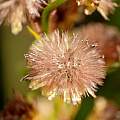Liatris commonly called Blazing-star, Gay-feather or Button snakeroot is a genus of ornamental plants in the Eupatorieae tribe of the Asteraceae family, native to North America. An unusual feature is that the flowers open from the top of the flower spike downwards. Liatris are generally easy from seed but will need 3-4 years to flower. Under good conditions they may self-sow, but as the seedheads are slowly ripening, this behavior is easy to control. The dry seed stands keep their form well, so they do offer a certain winter aspect.
Liatris aspera Michx, the Rough Blazing Star, has a widespread distribution from Michigan to the Carolinas and on westwards as far as Texas. The sessile, globose flower heads are arranged in a loose spike. It is best identified by the concave phyllaries getting their purple tips long before the flowers open. At its north-western limits it meets Liatris ligulistylis and forms intermediates. Height range: 2-3 ft. Pictures by Martin Bohnet.
Liatris ligulistylis (A.Nelson) K.Schum., Rocky Mountain or Meadow Blazing Star, is a widespread species occurring from southern Manitoba down to northern New Mexico. Its inflorescence features 5 to 20, each 2-3 cm wide flower heads on individual peduncles up to 5 cm long, giving it a rather loose and open appearance compared to the more commonly cultivated Liatris spicata. It prefers moderately moist to moist sites as it naturally inhabits prairies, meadows and stream banks. It is said to be a butterfly magnet in its home territory. The pictures show a plant grown from seed by Martin Bohnet, which flowered in its third year. Photo 3 shows the pubescent lower side of the leaves, about 1.5 months before flowering, Photo 4 shows a ripe seedhead.
Liatris pycnostachya Michx., the prarie blazing star, is a species mostly encountered to the west of the Mississippi very similar to Liatris spicata (which mostly grows east of it), and forms in horticulture may very often be hybrids of the two. Gaiser (1949) lists the form of the phyllaries as best defining difference, as they are acute and (slightly) reflexed in L. pycnostachya while ovoid and appressed in L. spicata. Another difference listed is a tendency to have a somewhat hirsute stem in L.pycnostachya, but that's not consistent throughout the population. For Martin Bohnet L. pycnostachia basically behaves like L. spicata "on steroids", being bigger in all parts, but again that's only partly supported by botanical literature.
Liatris spicata is a widely cultivated herbaceous hardy perennial, typically available in white and purple. Corms bought in winter will flower in late summer. More information about it can be found here. Although a member of Asteraceae, the flowers are not classic daisies as they have no ray florets. However, comparing photos 5 and 6 with those of the details of a more daisy like flower such as Dahlia reveals that what might appear to be wispy petals are extra large styles. Pictures by David Pilling.
Photo 1 shows corms as bought from a supermarket in early April; the coin is around 1 inch in diameter. Photo 2 confirms the description given at EOL: "The leaves are linear in shape and their margins are smooth (entire). Each leaf has a distinct central vein. Both the upper and lower leaf surfaces are light to medium green and glabrous to sparsely hairy." Photos 3 and 4 show the details of an individual floret. Photos 5 and 6 are of ripening seed.
Seed photo and ripe seed stand.






















